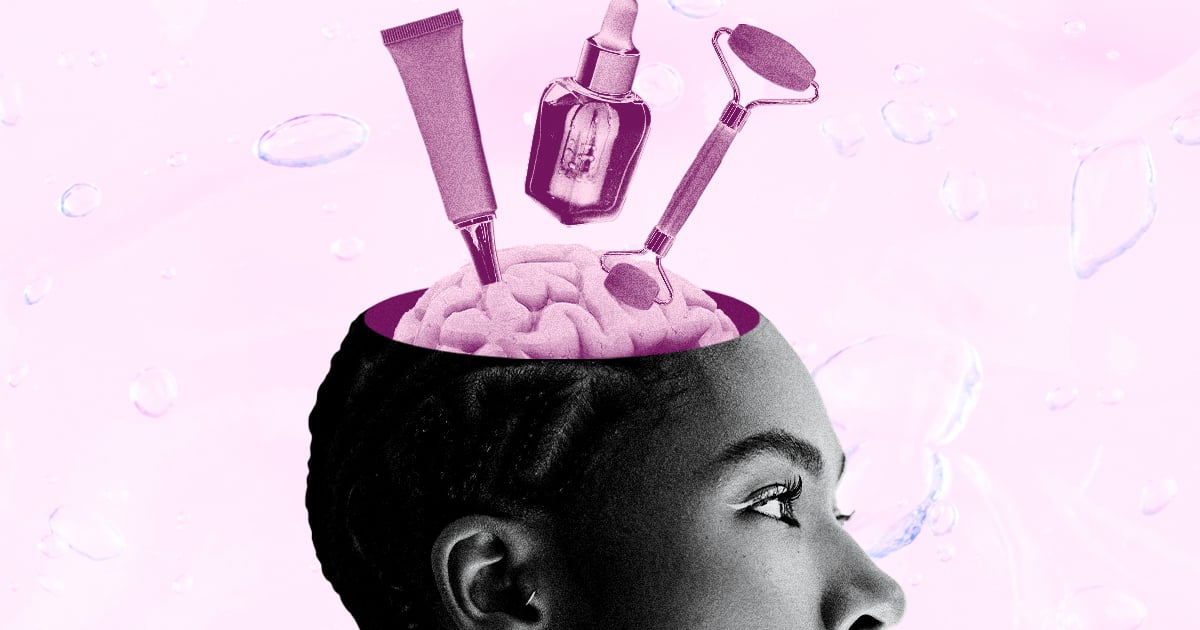With how saturated the beauty industry has become, it’s no longer enough for products to garner results. To win over beauty lovers, brands are banking on customers feeling something – transforming a regular skin-care product into an experience or event worth repeating. Similar to how nighttime products can prepare you for a restful sleep, a buzzy new category called “neurocosmetics” is gaining popularity in the emotional aspect of skin-care routines.
The concept of neurocosmetics is based on the fact that hormones produced by the brain can impact skin function. For example, if you’re stressed or going through a traumatic season, you might experience acne. Consequently, during a joy-filled season, your skin may appear dewy and refreshed.
“The skin and brain share the same embryonic origin, making the epidermis an extension of the nervous system,” brand founder Cedric Rimella tells PS. “This connection means that mental states impact skin health and vice versa. Neurocosmetics explores this dual communication, aiming to enhance skin and mental well-being through neuroactive ingredients.”
Although this concept is not necessarily new – neurocosmetic cosmetology started getting more attention by formulation chemists in 2007, says chemist Stas Chirkov – it’s the first time it’s been branded and named. In order to find out more details, we spoke to a handful of cosmetic chemists to uncover the science behind neurocosmetic, what benefits we can expect, and what’s next for the new, hit category.
Experts Featured in This Article
Cedric Rimella is the co-founder and CEO of neurocosmetics brand I.D. Swiss Botanicals.
Stas Chirkov is a chemist and founder of Blunt Skincare.
Ron Robinson is a cosmetic chemist and founder of BeautyStat.
Stephanie Lee is a founder of the neurocosmetic brand Selfmade.
What Are Neurocosmetics?
Where traditional cosmetics and skin-care products focus exclusively on the skin, neurocosmetics look for pathways to trigger the nervous system to positively impact the skin and well-being.
“Neurocosmetics are cosmetic and skin-care products that are designed to maintain skin homeostasis to prevent skin concerns like wrinkles or dull appearance, irritation, inflammation, and sensitive skin – all known to contribute to the aging of the skin,” Chirkov says. Neurocosmetics are created to interfere with those pathways before the skin is impacted.
Based on the concept that the skin and brain have a unique connection, it’s believed some topical ingredients can spark emotions and sensations. “Neurocosmetic ingredients can be any type of ingredient that affects the nerve receptor: topical ingredients, ingredients that we smell (aka aromatherapy), or ingredients we ingest,” cosmetic chemist Ron Robinson says.
To win over beauty lovers, brands are banking on customers feeling something – transforming a regular skin-care product into an experience or event worth repeating.
Neurocosmetics are not new. In fact, you’ve likely used them in your routine for quite some time. If you enjoy the cooling sensation from menthol products or the feeling of heat to relieve aches and pains from capsaicin muscle rub creams, you’ve experienced neurocosmetics. Not to mention, aromatherapy uses scent to affect mood and CBD products bind to cannabinoid receptors in the skin to reduce pain. Founder Stephanie Lee says neurocosmetics have become more trendy due to better technology and the current overflow of mental health concerns that these ingredients can address.
How Does Neuroscience Work in Skin Care?
“The science that underpins the relationship [between the skin and the brain] is called psychodermatology, which is a hybrid discipline of psychiatry and dermatology,” says Lee. “The skin not only protects and senses but is an endocrine organ that produces and transforms hormones.” Three functions have to operate in order for that to happen: the messenger, the signaler, and the regulator. The messenger is a network of fibers that live on the skin as the axons of sensory neurons – acting as an extension of the brain and spinal cord.
The signaler, or the skin stress response system, is a neuroendocrine system that locally produces hormones involved with melanin, inflammatory markers, metabolism, and mood boosters. Lastly, the regulator is the dermal hippocampus-pituitary-adrenal axis, where the skin and brain conspire together for coordinated and adaptive regulation of cortisol levels, immune function, metabolism, cardiovascular, emotional regulation, and skin barrier activity.
In other words, psychodermatology is a hybrid of psychiatry and dermatology that studies how your mind and emotions can influence your skin’s health and appearance. Most beauty and wellness operate on the opposite premise: how you look affects your emotions. Psychodermatology and our bodies tell us the real story: body function and performance correlate to our mental state. Lee thinks of the body as a home. Just like a home can have a security system, so can our body through the brain and skin axis. “We want three critical parts of the axis to be super connected, optimized for safety, and have healthy communication with each other. Using a typical home security system as a metaphor, it also has three parts (messenger, signaler, and the regulator) that work together to protect the house and its contents,” Lee says.
Chirkov says that, depending on the brand, modern technologies will use different mechanisms to deliver skin benefits like rebalancing cortisol levels, stimulating endorphins, or activating melatonin receptors in the skin. Brands like Neuraé use fragrances to trigger positive emotional reactions, like joy and energy. It discovered how this works by pooling a group of people using an electroencephalogram (a device that records brain activity) to record the brain’s electrical activity as people sniffed different scent notes, ultimately crafting a five-product assortment.
What Are The Benefits of Neurocosmetics?
At its core, neurocosmetics can help soothe sensitive skin experiencing conditions like acne, hyperpigmentation, and psoriasis, promoting a healthier complexion, says Chirkov. “Neurocosmetics might help you feel more relaxed and de-stressed; they also might help relieve pain,” Robinson says. It’s important to note that the field is still new and developing, and more research is being done to understand the long-term effects and benefits of neuroactive ingredients.
What’s Next for Neurocosmetics?
The majority of neurosomatic brands out there focus on touch and feelings. But as with technology advancements, it could take a long time before these features come to market.
Lee hopes neurocosmetics will teach consumers more about their bodies and the direct relationship between skin and their mental state. “The discipline and advancement of psychodermatology posits that emotional and stress intervention is a key piece to dermatological health,” she says. As research continues to explore the mind-skin connection, neurocosmetics have the potential to make beauty even more holistic, supporting both your skin and mental health.
Natasha Marsh is a freelance writer who writes about fashion, beauty, and lifestyle. Prior to freelancing, she held styling staff positions at The Wall Street Journal, Burberry, Cosmopolitan Magazine, British GQ, and Harpers Bazaar.




